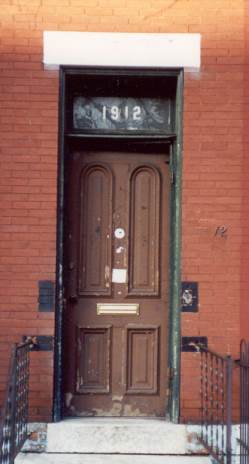Construction Details
All of the Caroline Street houses originally came with front yards enclosed with what was called Washington loop fencing. It was made of wrought iron and over the years much of it was replaced by a chain link variety. In recent years, however, much of that too has again been replaced with good replicas of the original fencing. 1515 retains the original, with the original stone foundation blocks still visible.
All houses had marble steps and landings (stoops). All have been retained, although the steps on 1524 were moved to the side during a reconstruction. The other Groff-built houses on the 15th Street and T Street sides of square 190 have the same steps and landing.
Crenelations appear on the top of the front facade of several houses, both flat- and indented-front, suggesting that all probably had them. They appear to have been evenly spaced, but no house retains a complete set.

|
The last original front door (a speculation) disappeared from the street when 1516 Caroline was extensively renovated in the mid-1980s. That door looked like the one in the picture above on 1912 15th Street, another Groff-built house. Examples of this style door (replacements) can be seen today on both 1910 and 1912 15th Street.
Original house windows were double hung, two over two panes. 1518 and 1522 may have original windows.[2]
There are enough vestiges of window hardware on several Caroline Street houses to indicate that all had shutters on the side and rear windows. This appears to have been a standard dwelling feature, at least with small houses. Research on old Southwest Washington, DC, conducted prior to the development of a walking route highlighting that neighborhood's history before urban renewal, revealed photographs showing the same side and rear shutter placement on houses of a similar size.[1] Similarly, because of the lack of window hardware on the front of Caroline Street houses it is safe to say that the shutters seen today are a much more recent addition.
Demolition for a kitchen project in 1502 Caroline showed that the rear chimney did not have any remainders of a fireplace, but rather a circular hole. This suggests that there was something like a Franklin stove. The living room, apparently had a Latrobe stove, according to a letter from the first resident of 1522, Paul Clendenin. The Latrobe was a fireplace insert that was far more efficient than an open fire. They were likely fueled by coal.
[1] Richard Busch research, 2002.
[2] Since December 1998, when it was so designated by the city's Historic Preservation Review Board, Caroline Street has been part of the Greater 14th Street Historic District. To ensure the future architectural integrity of the district, property owners must obtain approval from the Historic Preservation Office (part of the Office of Planning) for any exterior changes to their properties. This includes replacing windows and doors.
[3] Pictures by Dan Gamber, except for door picture by Rick Busch.
Last update 3 April 2005
Copyright Richard Busch, 1993, 2004-5
Blanket permission for downloading and reproduction for personal use is given.
Any commercial use without explicit written permission is prohibited.
home | previous page - interiors | next page - variations | contact